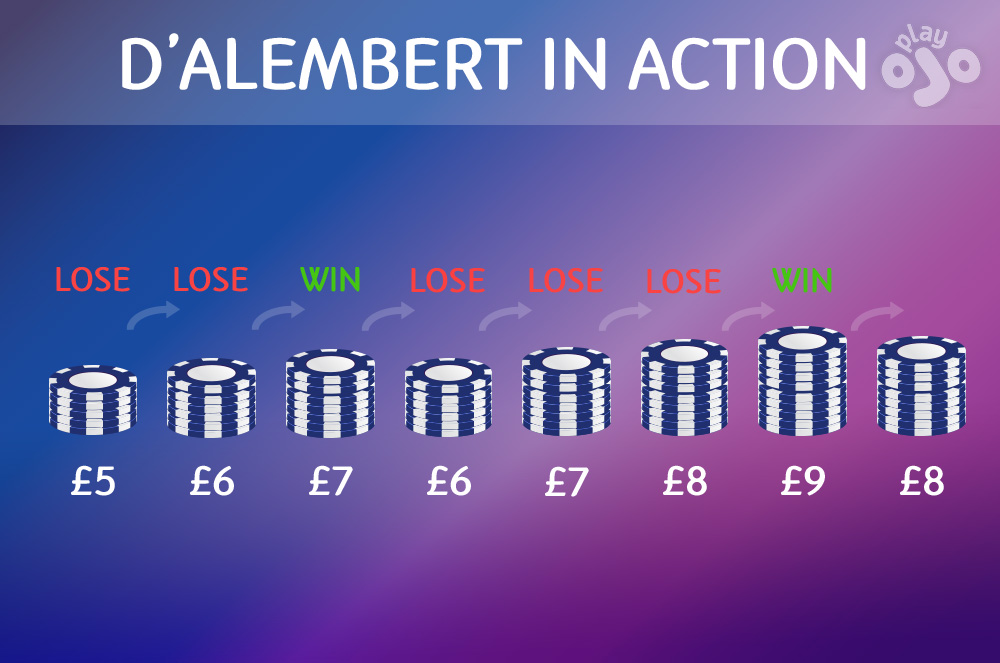D’Alembert & Contra D’Alembert Bet Systems
By Daniel Grant
Updated 10 Jul, 2025

What is the d’Alembert and reverse d’Alembert system?
The d’Alembert and Reverse d’Alembert – also called the Contra d’Alembert or Contra Bet roulette system – are among the favourite strategies of roulette players. We’re going to look at how they work and find out if it’s possible to win with them.
Many 18th century French mathematicians spent their spare time playing roulette and working out the perfect betting strategies, which explains why so many of the most popular roulette systems originated during this period.
With the benefit of hindsight (and some shrewd decisions by the casino industry), it seems they wasted their time, as none managed to find a reliable system that can turn a consistent profit in the modern roulette era.
They may be fatally flawed but it’s still interesting to analyse systems like the d’Alembert and the Contra d’Alembert bet systems to see if they have any interesting or useful features. And provided you apply them sensibly, they can be fun to play, too.
D’Alembert: A low risk roulette system or a slow-moving disaster?
The d’Alembert strategy is a negative progression system like Martingale, but with a much flatter structure which reduces the variance. It’s used on casino games like roulette with 1 to 1 or ‘even money’ bets, which have an almost 50% chance of success.
Despite being a scientist and mathematician, D’Alembert believed in something called the equilibrium effect which, when applied to gambling, claims that any short-term deviations must revert to the mean.
In normal language, you may well flip heads 10 times in a row but you’ll eventually flip enough tails to balance things up.

In roulette terms (ignoring the zero for now), a sequence of reds only makes a streak of blacks more likely, as the laws of probability find a way to balance the results out and reach the right equilibrium of reds and blacks.
It’s true that over 10,000 spins of the roulette wheel, we are likely to see almost exactly the same number of reds and blacks, and that the more spins we see, the closer they’ll be.
But that doesn’t mean after 6 reds in a row, black is now more likely to appear than red on the very next spin. The wheel has no memory, and many a gambler has fallen foul of this system by misunderstanding the nature of probability and independent chance events.
How to play the d’Alembert roulette system?
The d’Alembert system is one of the simplest to use, as you need only remember 2 rules.
Increase your bet by 1 unit when you lose
Decrease your bet by 1 unit when you win
You do still need to decide the size of your first bet. Some start with £1 and flat bet until they lose. Once they start increasing their bets, they can then decrease when they win. Others start with 5 units and raise or lower the bet by 1 unit, and so on.

But what bet types can we use with d’Alembert? This is a binary system that only works (if you can call it that) with even money bets with payout odds of 1 to 1.
In roulette, that means one of the following.
Red or black
Odd or even
High (19-36) or low (1-18)
Remember that once you’ve chosen a bet, you have to stick with it for the duration of your session. Start off with red, for instance, and you must stick with red until you leave the table.
Reverse d’Alembert or Contra bet system
If you’ve read my analysis of other systems in our roulette guide, you’ll know that I prefer positive progression systems where you bet smaller when you lose and bigger when you win.
The positive version of d’Alembert’s method is simply the inverse – you increase your bet when you win, and lower it when you lose. It’s easier to play your way into profit if the results go your way, and if they don’t, the downside is smaller.

How Contra d’Alembert works?
Flipping d’Alembert turns a negative progression system into a positive one, although as we’ll see, it doesn’t have a very radical impact on results.
Here’s what you need to know:
Choose your unit bet
Increase your bet by 1 unit when you win
Decrease your bet by 1 unit when you lose
If your previous bet was 1 unit and you lose, you continue at 1 unit
With both d’Alembert roulette systems, and in fact all systems, you should have profit and loss limits in mind, or you’ll simply continue until you bust your bankroll, fall asleep or slowly grind your way down. Once you hit your target or reach your loss limit, you walk away or start again with a bet of 1 unit.
Like the Paroli system, the Contra bet model relies on win streaks, but unlike the straight d’Alembert, if you go many spins without a win, you should still be around to take another shot.
Comparing Martingale v d’Alembert v Contra bet systems
It’s interesting to compare the d’Alembert and Contra bet systems to the most famous negative progression method of all, and see how we fare after an unlikely streak of losses. Bear in mind that in European roulette, the odds of losing 6 even money bets in a row is only 1 in 54 – far from impossible – and all roulette system players will have experienced a streak like this.
d’Alembert | Contra | Martingale | ||||
|---|---|---|---|---|---|---|
Result | Stake | P/L | Stake | P/L | Stake | P/L |
Lose | £1 | -£1 | £1 | -£1 | £1 | -£1 |
Lose | £2 | -£3 | £1 | -£2 | £2 | -£3 |
Lose | £3 | -£6 | £1 | -£3 | £4 | -£7 |
Lose | £4 | -£10 | £1 | -£4 | £8 | -£15 |
Lose | £5 | -£15 | £1 | -£5 | £16 | -£31 |
Lose | £6 | -£21 | £1 | -£6 | £32 | -£63 |
Win | £7 | -£14 | £1 | -£5 | £64 | £1 |
Win | £6 | -£8 | £2 | -£3 | £1 | £2 |
Win | £5 | -£3 | £3 | £0 | £1 | £3 |
Win | £4 | £1 | £4 | £4 | £1 | £4 |
For ease of comparison, I have used a £1 starting bet for both. After 6 losses in a row, we are down £63 with Martingale, £21 with d’Alembert and just £6 with the Contra d’Alembert. But although we have lost far more with the Martingale, we can wipe out all of those losses and return to profit if the next bet’s a winner. With both d’Alembert variants, we must dig our way slowly out of the hole with a succession of wins.
To recap, after 6 losses in a row, it takes just 1 winning bet using the very risky Martingale system to get back into profit, but it takes at least 3 wins in a row to erase the losses with one of the more conservative models.

With Martingale, the stakes are high, the swings are large, and we’re only ever 1 win away from getting back to square one (plus a little profit). That explains why it has been so popular, despite the potential for extreme risk and exponential losses.
With both d’Alembert systems, we take small steps forward and back, eking out a profit or slowly clawing back the losses, without exposing ourselves to huge bets in the process. It’s a credit to the Reverse d’Alembert model that we never risked more than 1 unit until we were in profit, and we came away with the biggest profit.
If you’re learning how to play roulette and considering using a betting system, it’s crucial to look at the betting model and understand how that affects the variance, your exposure to risk and ultimately, the fate of your bankroll.
Strengths and weaknesses
Aside from the obvious benefit of betting smaller increments than with a system like the Martingale, there are few reasons to use d’Alembert methods for real money. Simplicity is one popular reason but that’s scraping the barrel!
Pros
Lower risk – no need for huge bets or a big bankroll, or concern about table limits
Medium variance – fewer extreme moments mean less stress
Easy to learn – only 2 rules to remember, so it’s difficult to screw up!
Cons
Conservative model – big wins are impossible and a very lucky streak is needed to make even modest profit
House edge – The casino takes an average cut of at least 2.70% of every bet
Chasing losses – Due to the house edge, losing streaks are more likely than winning streaks and we bet bigger when they come along
A summary of the d’Alembert systems
Although the d’Alembert gambling system and its Contra bet brother are part of the same family of betting systems as Martingale, they are at the more conservative end of the spectrum.
To book a winning session using either d’Alembert system, you need to start well and stop immediately, or get lucky with a lengthy win streak somewhere along the way.
Although both are more cautious strategies for how to win at roulette, you can still find yourself facing big bets and unexpected losses, and because of the flatter betting structure, it’s much harder to get out of the hole once you’re in it.
A low variance strategy may sound like a good fit for you, but there are still risks involved and the odds are still dead against you making a profit in the long run.
Related Posts

Daniel Grant
About the Author
Dan Grant is a 25-year veteran of the gaming industry and a leading authority on iGaming content with over 1,000 articles on topics such as industry trends and bankroll strategy. He began in sports betting in 1997, then spent 11 years at a leading poker brand. As a content lead for iGaming marketing agencies, Dan has worked with over 30 regulated gaming brands, including giants like IGT. He also has a Law degree, providing a unique perspective on the regulatory complexities of the gaming market.
Availability depends on your country
















We use both automated and manual processes in order to verify the age of the customer registering the account and any player under the age of 18 who registers an account will have their account closed immediately.
We say NO to Underage Gambling . We do not allow players under the age of 18 to gamble. This is stated in our Terms and Conditions.
Trademark ™ 2025 PlayOJO. All rights reserved.
Apple and the Apple logo are trademarks of Apple Inc., registered in the U.S. and other countries. App Store is a service mark of Apple Inc., registered in the U.S. and other countries.
